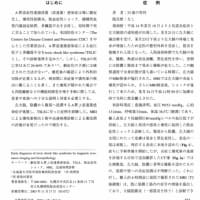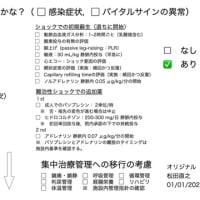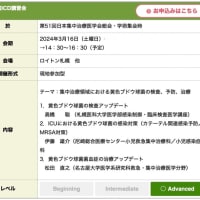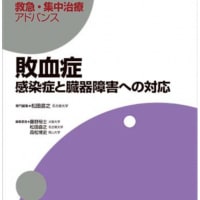Alert Cell Strategy in Severe Sepsis and Septic Shock PART4
Prof. Naoyuki Matsuda M.D., Ph.D.
Department of Emergency & Critical Care Medicine
Nagoya University Graduate School of Medicine, Nagoya, Japan
E-mail: nmatsuda@med.nagoya-u.ac.jp
References
1)Members of the American College of Chest Physicians/Society of Critical Care Medicine Consensus Conference Committee: Definitions for sepsis and organ failure and guidelines for the use of innovative therapies in sepsis. Crit Care Med 1992; 20: 864–74.
2)Angus DC, Linde-Zwirble WT, Lidicker J, et al. Epidemiology of severe sepsis in the United States: analysis of incidence, outcome, and associated costs of care. Crit Care Med 2001; 29:1303-10.
3)Dellinger RP, Carlet JM, Masur H, et al. Surviving sepsis campaign guidelines for management of severe sepsis and septic shock. Crit Care Med 2004; 32:858–73.
4)Dellinger RP, Levy MM, Carlet JM, et al. Surviving Sepsis Campaign: international guidelines for management of severe sepsis and septic shock: 2008. Crit Care Med 2008;36:296-327.
5)Lemaitre B, Nicolas E, Michaut L, et al. The dorsoventral regulatory gene cassette spatzle/Toll/cactus controls the potent antifungal response in Drosophila adults. Cell 1996; 86:973-83.
6)Kawai T, Akira S. TLR signaling. Cell Death Differ 2006; 13:816-25.
7)Matsuda N. Alert Cell Strategy. Circ Cont 2004; 25:276-84.
8)Matsuda N, Hattori Y. Systemic inflammatory response syndrome (SIRS): Molecular pathophysiology and gene therapy. J Pharmacol Sci 2006; 101: 189-98.
9)Cartwright N, Murch O, McMaster SK, et al. Selective NOD1 agonists cause shock and organ injury/dysfunction in vivo. Am J Respir Crit Care Med 2007; 175:595-603.
10)Shen HM, Pervaiz S. TNF receptor superfamily-induced cell death: redox-dependent execution. FASEB J 2006; 20:1589-98.
11) Boraschi D, Tagliabue A. The interleukin-1 receptor family. Vitam Horm 2006; 74:229-54.
12) Scheller J, Rose-John S. Interleukin-6 and its receptor: from bench to bedside. Med Microbiol Immunol 2006; 195:173-83.
13)Kishimoto T, Akira S, Taga T. IL-6 receptor and mechanism of signal transduction. Int J Immunopharmacol 1992; 14:431-8.
14)Becker CE, O'neill LA. Inflammasomes in inflammatory disorders: the role of TLRs and their interactions with NLRs. Semin Immunopathol 2007; 29:239-48.
15)Kanazawa N. Dendritic cell immunoreceptors: C-type lectin receptors for pattern-recognition and signaling on antigen-presenting cells. J Dermatol Sci 2007; 45:77-86.
16)Lutterloh EC, Opal SM. Antibodies against RAGE in sepsis and inflammation: implications for therapy. Expert Opin Pharmacother 2007; 8:1193-6.
17)Leger AJ, Covic L, Kuliopulos A. Protease-activated receptors in cardiovascular diseases. Circulation 2006; 114:1070-7.
18)Syeda F, Grosjean J, Houliston RA, et al. Cyclooxygenase-2 induction and prostacyclin release by protease-activated receptors in endothelial cells require cooperation between mitogen-activated protein kinase and NF-κB pathways. J Biol Chem. 2006; 281:11792-804.
19)Matsuda N, Yamazaki H, Takano K, et al. Priming by lipopolysaccharide exaggerates acute lung injury and mortality in responses to peptidoglycan through up-regulation of Toll-like receptor-2 expression in mice. Biochem Pharmacol 2008;75:1065-75.
20)Saitoh S, Miyake K. Mechanism regulating cell surface expression and activation of Toll-like receptor 4. Chem Rec 2006; 6:311-9.
21)Matsuda N, Nishihira J, Takahashi Y, et al. Role of macrophage migration inhibitory factor in acute lung injury in mice with acute pancreatitis complicated by endotoxemia. Am J Respir Cell Mol Biol 2006 ;35:198-205.
22)Matsuda N, Hayashi Y, Takahashi Y, et al. Phosphorylation of endothelial nitric-oxide synthase is diminished in mesenteric arteries from septic rabbits depending on the altered phosphatidylinositol 3-kinase/Akt pathway: reversal effect of fluvastatin therapy. J Pharmacol Exp Ther 2006; 319:1348-54.
23)Matsuda N, Takano Y, Kageyama S, et al. Silencing of caspase-8 and caspase-3 by RNA interference prevents vascular endothelial cell injury in mice with endotoxic shock. Cardiovasc Res 2007; 76:132-40.
24)Leeper-Woodford SK, Detmer K. Acute hypoxia increases alveolar tumor necrosis factor activity and alters NF-kB expression. Am J Physiol 1999;276:L909–16.
25) Matsuda N, Yamamoto S, Takano K, et al. Silencing of fas-associated death domain protects mice from septic lung inflammation and apoptosis. Am J Respir Crit Care Med 2009;179:806-15.
26) Matsuda N, Teramae H, Yamamoto S, et al. Increased death receptor pathway of apoptotic signaling in septic mouse aorta: effect of systemic delivery of FADD siRNA. Am J Physiol Heart Circ Physiol 2010;298:H92-101.
27)Kulms D, Schwarz T. NF-κB and cytokines. Vitam Horm 2006; 74:283-300.
28)Krappmann D, Scheidereit C. A pervasive role of ubiquitin conjugation in activation and termination of IkB kinase pathways. EMBO Rep 2004; 6:321-6.
29)Bates PW, Miyamoto S. Expanded nuclear roles for IkBζ. Sci STKE 2004; 254:48.
30)Gross S, Piwnica-Worms D. Real-time imaging of ligand-induced IKK activation in intact cells and in living mice. Nat Methods 2005; 2:607-14.
31)Anest V, Hanson JL, Cogswell PC, et al. A nucleosomal function for IkB kinase-α in NF-κB-dependent gene expression. Nature 2003; 423:659-3.
32)Kamiyama K, Matsuda N, Yamamoto S, et al. Modulation of glucocorticoid receptor expression, inflammation, and cell apoptosis in septic guinea pig lungs using methylprednisolone. Am J Physiol Lung Cell Mol Physiol 2008;295:L998-1006.
33)Matsuda N, Hattori Y, Takahashi Y, et al. Therapeutic effect of in vivo transfection of transcription factor decoy to NF-κB on septic lung in mice. Am J Physiol Lung Cell Mol Physiol 2004; 287: L1248-55.
34)Matsuda N, Hattori Y, Takahashi Y, et al. Nuclear Factor-kB decoy oligonucleotides prevent acute lung injury in mice with cecal ligation and puncture-induced sepsis. Mol Pharmacol 2005; 67:1018-25.
35)Matsuda N, Yamamoto S, Yokoo H, et al. Nuclear factor-kappaB decoy oligodeoxynucleotides ameliorate impaired glucose tolerance and insulin resistance in mice with cecal ligation and puncture-induced sepsis. Crit Care Med 2009 ;37:2791-9.
36)Karin M, Lin A. NF-κB at the crossroads of life and death. Nat Immunol 2002; 3:221-7.
37)Mutunga M, Fulton B, Bullock R, et al. Circulating endothelial cells in patients with septic shock. Am J Respir Crit Care Med 2001; 163:195-200.
38)Hotchkiss RS, Karl IE. Endothelial cell apoptosis in sepsis: a case of habeas corpus? Crit Care Med 2004; 32:901-2.
39)Hehlgans T, Pfeffer K. The intriguing biology of the tumour necrosis factor/tumour necrosis factor receptor superfamily: players, rules and the games. Immunology 2005; 115:1-20.
40)Matsuda N. Molecular strategy for alveolar protection in severe ARDS. J Anesth 2007; 21:118-9.
41)Matsuda N, Teramae H, Futatsugi M, et al. Up-regulation of histamine H4 receptors contributes to splenic apoptosis in septic mice: counteraction of the antiapoptotic action of nuclear factor-kappaB. J Pharmacol Exp Ther 2010;332:730-7.
42)Shaulian E, Karin M. AP-1 as a regulator of cell life and death. Nat Cell Biol 2002; 4:E131-6.
43)Reddy SP, Mossman BT. Role and regulation of activator protein-1 in toxicant-induced responses of the lung. Am J Physiol Lung Cell Mol Physiol 2002; 283:L1161-78.
44)Ozanne BW, Spence HJ, McGarry LC, et al. Transcription factors control invasion: AP-1 the first among equals. Oncogene 2007; 26:1-10.
45)Lin Z, Hamik A, Jain R, et al. Kruppel-like factor 2 inhibits protease activated receptor-1 expression and thrombin-mediated endothelial activation. Arterioscler Thromb Vasc Biol. 2006; 26:1185-9.
46)Parmar KM, Nambudiri V, Dai G, et al. Statins exert endothelial atheroprotective effects via the KLF2 transcription factor. J Biol Chem 2005; 280:26714-9.
47) Sen-Banerjee S, Mir S, Lin Z, et al. Kruppel-like factor 2 as a novel mediator of statin effects in endothelial cells. Circulation 2005; 112:720-6.
48) Hamik A, Lin Z, Kumar A, et al. Kruppel-like factor 4 regulates endothelial inflammation. J Biol Chem 2007; 282:13769-79.
49)Matsuda N, Hattori Y, Zhang XH, et al. Contractions to histamine in pulmonary and mesenteric arteries from endotoxemic rabbits: modulation by vascular expressions of inducible nitric oxide synthase and histamine H1-receptors. J Pharmacol Exp Ther 2003; 307:175-81.
50)Kumar A, Lin Z, SenBanerjee S, et al. Tumor necrosis factor alpha-mediated reduction of KLF2 is due to inhibition of MEF2 by NF-κB and histone deacetylases. Mol Cell Biol 2005; 25:5893-903.
Remarks
This manuscript will give foreign researchers to develop a new drug for systemic inflammation including sepsis.
I am looking forward to the participation of foreign researchers into our laboratory in the near future.
Prof. Naoyuki Matsuda M.D., Ph.D.
Department of Emergency & Critical Care Medicine
Nagoya University Graduate School of Medicine, Nagoya, Japan
E-mail: nmatsuda@med.nagoya-u.ac.jp
References
1)Members of the American College of Chest Physicians/Society of Critical Care Medicine Consensus Conference Committee: Definitions for sepsis and organ failure and guidelines for the use of innovative therapies in sepsis. Crit Care Med 1992; 20: 864–74.
2)Angus DC, Linde-Zwirble WT, Lidicker J, et al. Epidemiology of severe sepsis in the United States: analysis of incidence, outcome, and associated costs of care. Crit Care Med 2001; 29:1303-10.
3)Dellinger RP, Carlet JM, Masur H, et al. Surviving sepsis campaign guidelines for management of severe sepsis and septic shock. Crit Care Med 2004; 32:858–73.
4)Dellinger RP, Levy MM, Carlet JM, et al. Surviving Sepsis Campaign: international guidelines for management of severe sepsis and septic shock: 2008. Crit Care Med 2008;36:296-327.
5)Lemaitre B, Nicolas E, Michaut L, et al. The dorsoventral regulatory gene cassette spatzle/Toll/cactus controls the potent antifungal response in Drosophila adults. Cell 1996; 86:973-83.
6)Kawai T, Akira S. TLR signaling. Cell Death Differ 2006; 13:816-25.
7)Matsuda N. Alert Cell Strategy. Circ Cont 2004; 25:276-84.
8)Matsuda N, Hattori Y. Systemic inflammatory response syndrome (SIRS): Molecular pathophysiology and gene therapy. J Pharmacol Sci 2006; 101: 189-98.
9)Cartwright N, Murch O, McMaster SK, et al. Selective NOD1 agonists cause shock and organ injury/dysfunction in vivo. Am J Respir Crit Care Med 2007; 175:595-603.
10)Shen HM, Pervaiz S. TNF receptor superfamily-induced cell death: redox-dependent execution. FASEB J 2006; 20:1589-98.
11) Boraschi D, Tagliabue A. The interleukin-1 receptor family. Vitam Horm 2006; 74:229-54.
12) Scheller J, Rose-John S. Interleukin-6 and its receptor: from bench to bedside. Med Microbiol Immunol 2006; 195:173-83.
13)Kishimoto T, Akira S, Taga T. IL-6 receptor and mechanism of signal transduction. Int J Immunopharmacol 1992; 14:431-8.
14)Becker CE, O'neill LA. Inflammasomes in inflammatory disorders: the role of TLRs and their interactions with NLRs. Semin Immunopathol 2007; 29:239-48.
15)Kanazawa N. Dendritic cell immunoreceptors: C-type lectin receptors for pattern-recognition and signaling on antigen-presenting cells. J Dermatol Sci 2007; 45:77-86.
16)Lutterloh EC, Opal SM. Antibodies against RAGE in sepsis and inflammation: implications for therapy. Expert Opin Pharmacother 2007; 8:1193-6.
17)Leger AJ, Covic L, Kuliopulos A. Protease-activated receptors in cardiovascular diseases. Circulation 2006; 114:1070-7.
18)Syeda F, Grosjean J, Houliston RA, et al. Cyclooxygenase-2 induction and prostacyclin release by protease-activated receptors in endothelial cells require cooperation between mitogen-activated protein kinase and NF-κB pathways. J Biol Chem. 2006; 281:11792-804.
19)Matsuda N, Yamazaki H, Takano K, et al. Priming by lipopolysaccharide exaggerates acute lung injury and mortality in responses to peptidoglycan through up-regulation of Toll-like receptor-2 expression in mice. Biochem Pharmacol 2008;75:1065-75.
20)Saitoh S, Miyake K. Mechanism regulating cell surface expression and activation of Toll-like receptor 4. Chem Rec 2006; 6:311-9.
21)Matsuda N, Nishihira J, Takahashi Y, et al. Role of macrophage migration inhibitory factor in acute lung injury in mice with acute pancreatitis complicated by endotoxemia. Am J Respir Cell Mol Biol 2006 ;35:198-205.
22)Matsuda N, Hayashi Y, Takahashi Y, et al. Phosphorylation of endothelial nitric-oxide synthase is diminished in mesenteric arteries from septic rabbits depending on the altered phosphatidylinositol 3-kinase/Akt pathway: reversal effect of fluvastatin therapy. J Pharmacol Exp Ther 2006; 319:1348-54.
23)Matsuda N, Takano Y, Kageyama S, et al. Silencing of caspase-8 and caspase-3 by RNA interference prevents vascular endothelial cell injury in mice with endotoxic shock. Cardiovasc Res 2007; 76:132-40.
24)Leeper-Woodford SK, Detmer K. Acute hypoxia increases alveolar tumor necrosis factor activity and alters NF-kB expression. Am J Physiol 1999;276:L909–16.
25) Matsuda N, Yamamoto S, Takano K, et al. Silencing of fas-associated death domain protects mice from septic lung inflammation and apoptosis. Am J Respir Crit Care Med 2009;179:806-15.
26) Matsuda N, Teramae H, Yamamoto S, et al. Increased death receptor pathway of apoptotic signaling in septic mouse aorta: effect of systemic delivery of FADD siRNA. Am J Physiol Heart Circ Physiol 2010;298:H92-101.
27)Kulms D, Schwarz T. NF-κB and cytokines. Vitam Horm 2006; 74:283-300.
28)Krappmann D, Scheidereit C. A pervasive role of ubiquitin conjugation in activation and termination of IkB kinase pathways. EMBO Rep 2004; 6:321-6.
29)Bates PW, Miyamoto S. Expanded nuclear roles for IkBζ. Sci STKE 2004; 254:48.
30)Gross S, Piwnica-Worms D. Real-time imaging of ligand-induced IKK activation in intact cells and in living mice. Nat Methods 2005; 2:607-14.
31)Anest V, Hanson JL, Cogswell PC, et al. A nucleosomal function for IkB kinase-α in NF-κB-dependent gene expression. Nature 2003; 423:659-3.
32)Kamiyama K, Matsuda N, Yamamoto S, et al. Modulation of glucocorticoid receptor expression, inflammation, and cell apoptosis in septic guinea pig lungs using methylprednisolone. Am J Physiol Lung Cell Mol Physiol 2008;295:L998-1006.
33)Matsuda N, Hattori Y, Takahashi Y, et al. Therapeutic effect of in vivo transfection of transcription factor decoy to NF-κB on septic lung in mice. Am J Physiol Lung Cell Mol Physiol 2004; 287: L1248-55.
34)Matsuda N, Hattori Y, Takahashi Y, et al. Nuclear Factor-kB decoy oligonucleotides prevent acute lung injury in mice with cecal ligation and puncture-induced sepsis. Mol Pharmacol 2005; 67:1018-25.
35)Matsuda N, Yamamoto S, Yokoo H, et al. Nuclear factor-kappaB decoy oligodeoxynucleotides ameliorate impaired glucose tolerance and insulin resistance in mice with cecal ligation and puncture-induced sepsis. Crit Care Med 2009 ;37:2791-9.
36)Karin M, Lin A. NF-κB at the crossroads of life and death. Nat Immunol 2002; 3:221-7.
37)Mutunga M, Fulton B, Bullock R, et al. Circulating endothelial cells in patients with septic shock. Am J Respir Crit Care Med 2001; 163:195-200.
38)Hotchkiss RS, Karl IE. Endothelial cell apoptosis in sepsis: a case of habeas corpus? Crit Care Med 2004; 32:901-2.
39)Hehlgans T, Pfeffer K. The intriguing biology of the tumour necrosis factor/tumour necrosis factor receptor superfamily: players, rules and the games. Immunology 2005; 115:1-20.
40)Matsuda N. Molecular strategy for alveolar protection in severe ARDS. J Anesth 2007; 21:118-9.
41)Matsuda N, Teramae H, Futatsugi M, et al. Up-regulation of histamine H4 receptors contributes to splenic apoptosis in septic mice: counteraction of the antiapoptotic action of nuclear factor-kappaB. J Pharmacol Exp Ther 2010;332:730-7.
42)Shaulian E, Karin M. AP-1 as a regulator of cell life and death. Nat Cell Biol 2002; 4:E131-6.
43)Reddy SP, Mossman BT. Role and regulation of activator protein-1 in toxicant-induced responses of the lung. Am J Physiol Lung Cell Mol Physiol 2002; 283:L1161-78.
44)Ozanne BW, Spence HJ, McGarry LC, et al. Transcription factors control invasion: AP-1 the first among equals. Oncogene 2007; 26:1-10.
45)Lin Z, Hamik A, Jain R, et al. Kruppel-like factor 2 inhibits protease activated receptor-1 expression and thrombin-mediated endothelial activation. Arterioscler Thromb Vasc Biol. 2006; 26:1185-9.
46)Parmar KM, Nambudiri V, Dai G, et al. Statins exert endothelial atheroprotective effects via the KLF2 transcription factor. J Biol Chem 2005; 280:26714-9.
47) Sen-Banerjee S, Mir S, Lin Z, et al. Kruppel-like factor 2 as a novel mediator of statin effects in endothelial cells. Circulation 2005; 112:720-6.
48) Hamik A, Lin Z, Kumar A, et al. Kruppel-like factor 4 regulates endothelial inflammation. J Biol Chem 2007; 282:13769-79.
49)Matsuda N, Hattori Y, Zhang XH, et al. Contractions to histamine in pulmonary and mesenteric arteries from endotoxemic rabbits: modulation by vascular expressions of inducible nitric oxide synthase and histamine H1-receptors. J Pharmacol Exp Ther 2003; 307:175-81.
50)Kumar A, Lin Z, SenBanerjee S, et al. Tumor necrosis factor alpha-mediated reduction of KLF2 is due to inhibition of MEF2 by NF-κB and histone deacetylases. Mol Cell Biol 2005; 25:5893-903.
Remarks
This manuscript will give foreign researchers to develop a new drug for systemic inflammation including sepsis.
I am looking forward to the participation of foreign researchers into our laboratory in the near future.



























